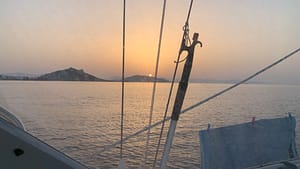The weather forecast said wind from the south and southeast. Still, we chose to sail to the harbor in Kyrckbacken on Hven and ducked in a shower of wind and rain. We sailed around the harbor. There were many free places, but none sheltered from the wind.
That's why we sailed out of the harbor. After half an hour we docked at the harbor in Norreborg, which is located on the north side of Hven. Here, as expected, there was shelter from the southerly wind.
We were the only guest boat. Enjoyed the peace, the singing of the birds and the sunset.
The next day we walked the path along the water. The weather was fine. It started to remind me of summer.
We passed the houses with the well-kept gardens and the campsite. A sign at the entrance advertised 'Fatöl', 'Coffee with fika' and 'Hamburgara'. We continued to the lighthouse on the northeastern tip of the island. From there we went on to the island's third port in Backviken. Here we took a break at a cafe.
Tycho Brahe
Now left by the water. Went up the steep hill and into the middle of the island to Tycho Brahe's Uranienborg.
Tycho Brahe, whose original name is Thyge Ottesen Brahe, was born in Scania in 1546 and died in Prague in 1601.
He is known as an astronomer. His work is considered the basis of Johan Kepler's theory. It proves that the earth revolves around the sun. At that time, astronomy and astrology were one and the same science. So it is not so strange that Tycho Brahe found that 32 of the days of the year bring misfortune. This is what we even today call a Tycho Brahe day. On these days, it is wise to refrain from important tasks.
Sophie Brahe
Tycho Brahe's sister Sophie Brahe was also a skilled mathematician. She helped with the research at the observatory - albeit in secret. At the time, it was believed that women's brains were damaged by working with mathematics.
Tycho Brahe's Who
In 1576, the Danish king Frederik II entrusted Hven to Tycho Brahe. The observatory Stjerneborg and the castle Uranienborg were built. In order to be able to print the scientific results, he built a paper mill and a printing house.
Tycho Brahe was a hard gentleman and was hated by the local people. At 1597 he had to leave the island and settle in Prague.
There are many myths about the cause of his death. One says he died of poisoning from the lead he had in his nose. Another says he held his water during a dinner so long that his bladder exploded. A third that he died of a urinary tract infection and a fourth says that Kepler poisoned him.
The sister Sophie moved to Helsingør, where she died in 1643. She was 87 years old, which must have been a very old age by the standards of the time
When we got back to Norreborg Harbour, more guest boats had arrived and we had another nice evening.
The next day we sailed to Rungsted. We had lunch on the boat: went for a walk on the promenade. Where you come to see to be seen. At the end of the afternoon we sailed home to Humlebæk Harbour.

